2016 MERCEDES-BENZ GLA key battery
[x] Cancel search: key batteryPage 293 of 390
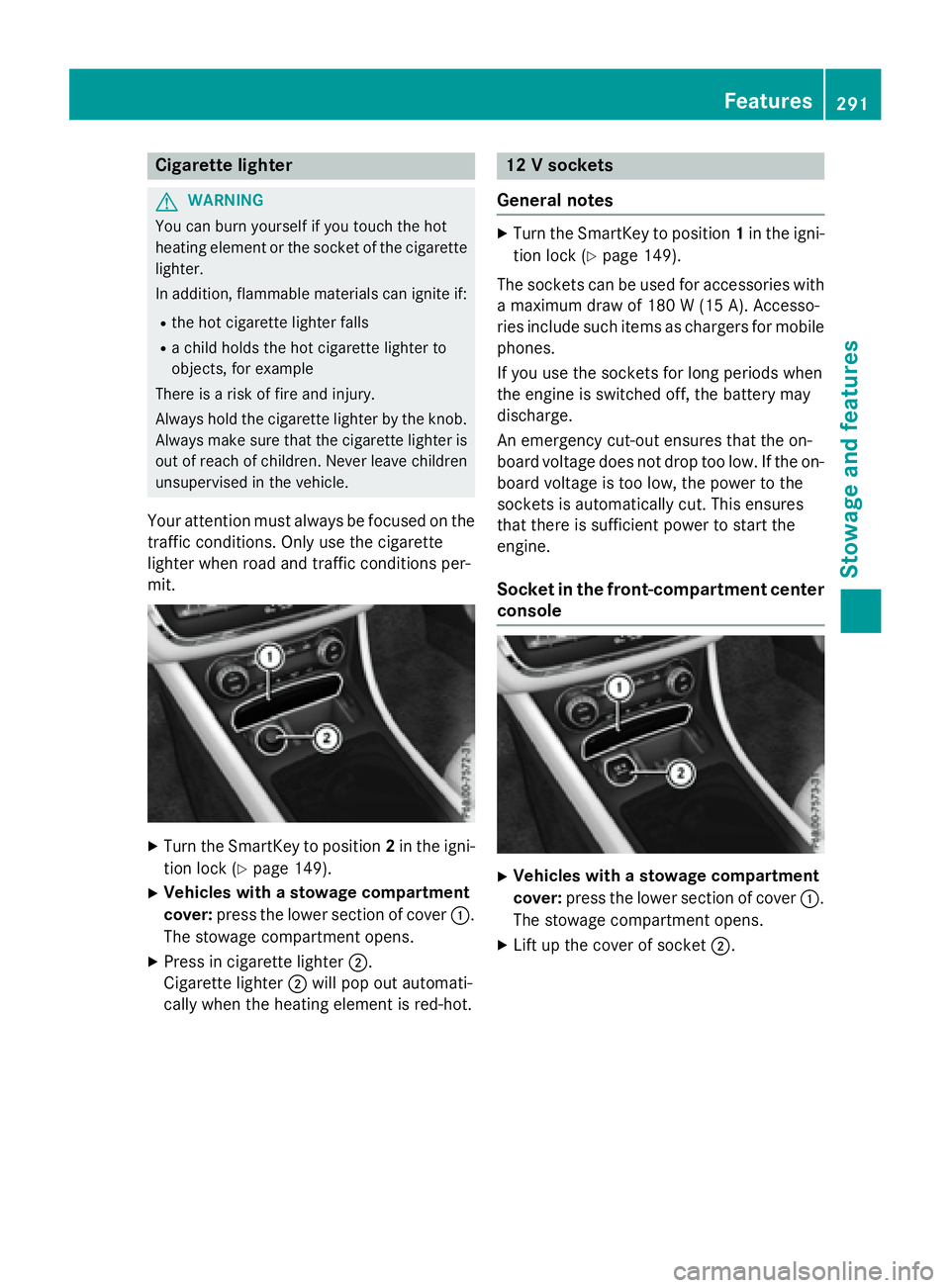
Cigarette lighter
G WARNING
You can burn yourself if you touch the hot
heating element or the socket of the cigarette
lighter.
In addition, flammable materials can ignite if: R
the hot cigarette lighter falls R
a child holds the hot cigarette lighter to
objects, for example
There is a risk of fire and injury.
Always hold the cigarette lighter by the knob.
Always make sure that the cigarette lighter is
out of reach of children. Never leave children
unsupervised in the vehicle.
Your attention must always be focused on the
traffic conditions. Only use the cigarette
lighter when road and traffic conditions per-
mit.
X
Turn the SmartKey to position 2 in the igni-
tion lock ( Y
page 149).X
Vehicles with a stowage compartment
cover: press the lower section of cover �C .
The stowage compartment opens. X
Press in cigarette lighter �D .
Cigarette lighter �D will pop out automati-
cally when the heating element is red-hot. 12 V sockets
General notes X
Turn the SmartKey to position 1 in the igni-
tion lock ( Y
page 149).
The sockets can be used for accessories with
a maximum draw of 180 W (15 A). Accesso-
rie s include suc h item s as charger s fo r mobile
phones.
If you use th e sockets fo r lon g period s whe n
th e engin e is switched off, th e battery may
discharge.
An emergency cut-out ensures that th e on -
boar d voltage doe s no t drop to o low. If th e on -
boar d voltage is to o low, th e power to th e
sockets is automatically cut . Thi s ensures
that ther e is sufficien t power to start th e
engine.
Socket in th e front-co mpartment center
console
X
Vehicles with a stowage compartment
cover: press the lower section of cover �C .
The stowage compartment opens. X
Lift up the cover of socket �D .Features 291
Sto wag e an d features Z
Page 330 of 390
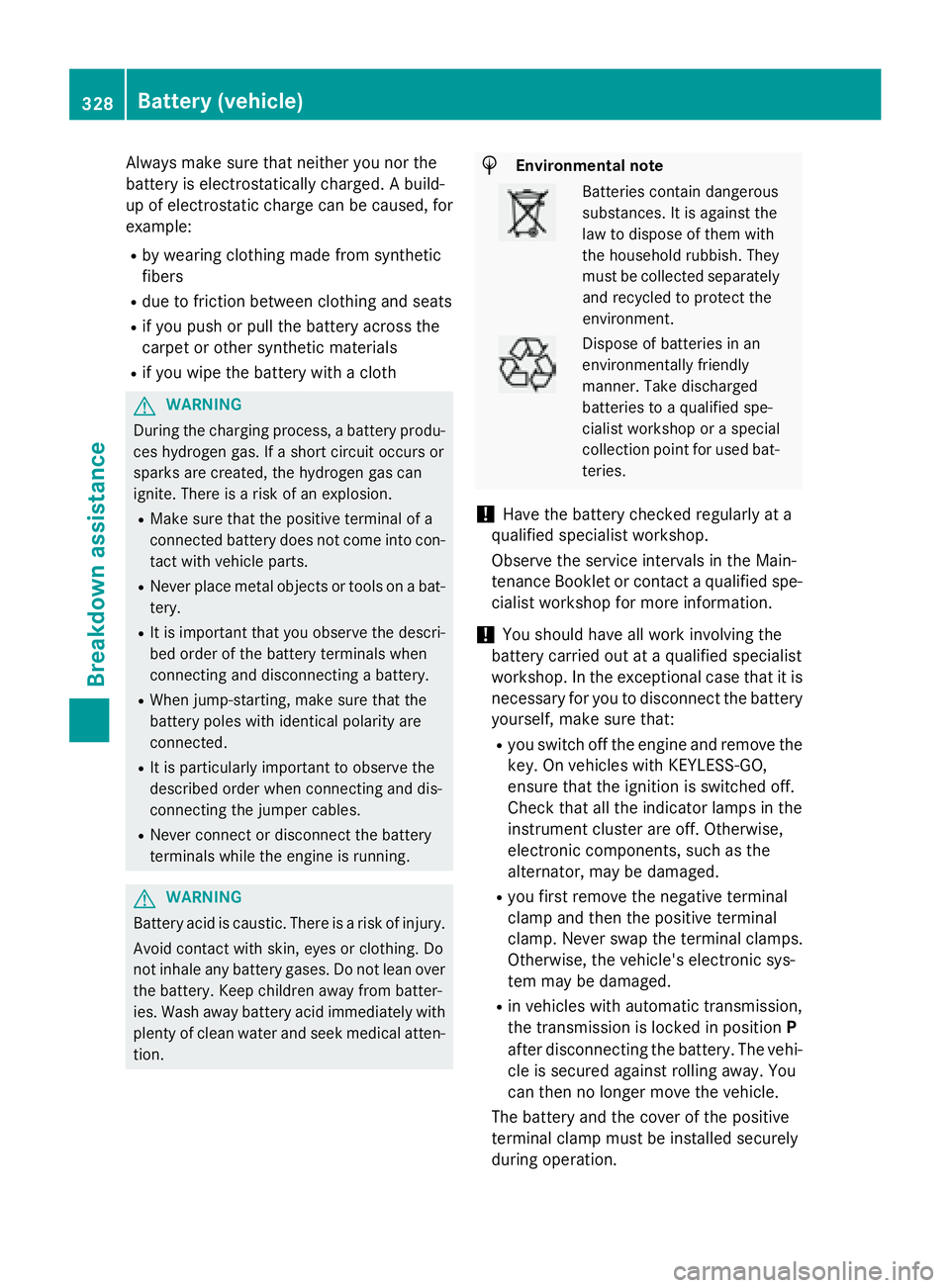
Always make sure that neither you nor the
battery is electrostatically charged. A build-
up of electrostatic charge can be caused, for
example: R
by wearing clothing made from synthetic
fibers R
due to friction between clothing and seats R
if you push or pull the battery across the
carpet or other synthetic materials R
if you wipe the battery with a cloth
G WARNING
During the charging process, a battery produ-
ces hydrogen gas. If a short circuit occurs or
sparks are created, the hydrogen gas can
ignite. There is a risk of an explosion. R
Make sure that the positive terminal of a
connected battery does not come into con-
tact with vehicle parts. R
Never place metal objects or tools on a bat-
tery. R
It is important that you observe the descri-
bed order of the battery terminals when
connecting and disconnecting a battery. R
When jump-starting, make sure that the
battery poles with identical polarity are
connected. R
It is particularly important to observe the
described order when connecting and dis-
connecting the jumper cables. R
Never connect or disconnect the battery
terminals while the engine is running.
G WARNING
Battery acid is caustic. There is a risk of injury.
Avoid contact with skin, eyes or clothing. Do
not inhale any battery gases. Do not lean over
the battery. Keep children away from batter-
ies. Wash away battery acid immediately with
plenty of clean water and seek medical atten-
tion. H Environmental note
Batteries contain dangerous
substances. It is against the
law to dispose of them with
the household rubbish. They
must be collected separately
and recycled to protect the
environment.
Dispose of batteries in an
environmentally friendly
manner. Take discharged
batteries to a qualified spe-
cialist workshop or a special
collection point for used bat-
teries.
! Have the battery checked regularly at a
qualified specialist workshop.
Observe the service intervals in the Main-
tenance Booklet or contact a qualified spe-
cialist workshop for more information.
! You should have all work involving the
battery carried out at a qualified specialist
workshop. In the exceptional case that it is
necessary for you to disconnect the battery
yourself, make sure that: R
you switch off the engine and remove the
key. On vehicles with KEYLESS-GO,
ensure that the ignition is switched off.
Check that all the indicator lamps in the
instrument cluster are off. Otherwise,
electronic components, such as the
alternator, may be damaged. R
you first remove the negative terminal
clamp and then the positive terminal
clamp. Never swap the terminal clamps.
Otherwise, the vehicle's electronic sys-
tem may be damaged. R
in vehicles with automatic transmission,
the transmission is locked in position P
after disconnecting the battery. The vehi-
cle is secured against rolling away. Yo u
ca n
then no longer move the vehicle.
The battery and the cover of the positive
terminal clamp must be installed securely
during operation.328
Battery (vehicle)
Breakdo wn assis tance
Page 331 of 390
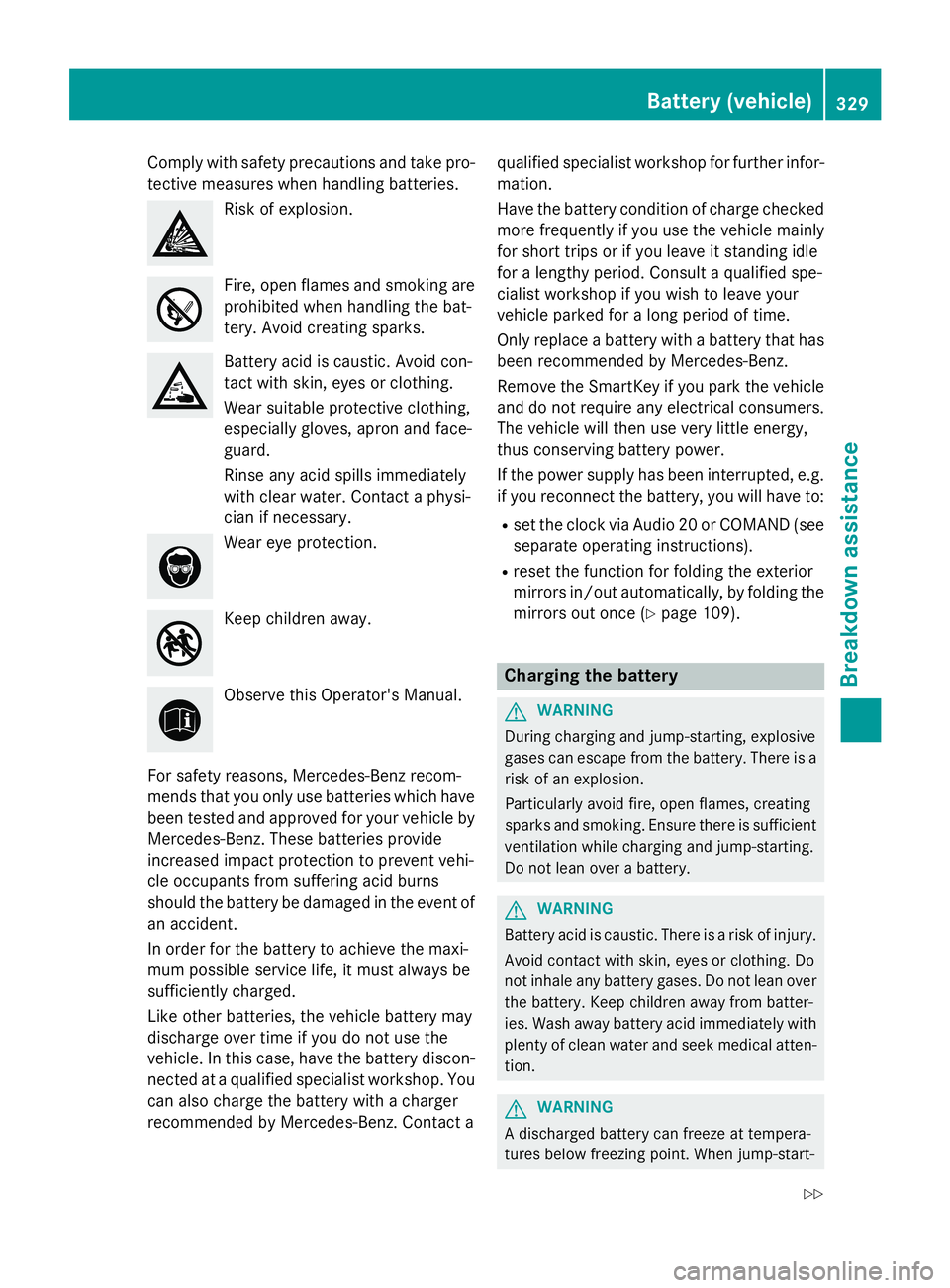
Comp ly wit h safety precautions and take pro-
tective measures when han dlin g batteries.
Risk of explosion.
Fire, open flames and smoking are
prohibited when handling the bat-
tery. Avoid creating sparks.
Battery acid is caustic. Avoid con-
tact wit h skin, eyes or clothing.
Wear suit able protective clothing,
especial ly gloves, apron and face-
guard.
Rins e any acid spills immediately
wit h clear water. Contact a physi-
cian if necessary.
Wear eye protection.
Keep children away.
Observe th is Operator's Manual.
For safety reasons, Mercedes-Benz recom-
men ds that you only use batteries which have
been tested and approved for your vehicle by
Mercedes-Benz. These batteries pro vide
increased impact protection to prevent veh i-
cle occupants from suffering acid burns
should the battery be damaged in the event of
an acc iden t.
In order for the battery to achieve the max i-
mum poss ible service life, it must always be
suff icie nt ly charge d.
Like other batteries, the vehicle battery may
disc harge over time if you do not use the
veh icle . In th is case, have the battery discon-
nected at a qualif ied specialist workshop. You
can also charge the battery with a charger
recommended by Mercedes-Benz. Contact a qualif ied spec ialist workshop for further infor-
mation.
Have the battery condition of charge checked
more frequently if you use the vehicle main ly
for short trips or if you leave it standing idle
for a lengthy per iod. Consult a qualif ied spe-
cialist workshop if you wish to leave your
vehicle parked for a long period of time.
On ly replace a battery with a battery that has
been recommended by Mercedes-Benz.
Remo ve the Sm artKey if you park the vehicle
and do not require any electrical consumers.
The vehicle will then use very lit tle energy,
t hus conserving battery power.
If the power supply has been interrupted, e.g.
if you reconnect the battery, you will have to:R
set the clock via Aud io 20 or COMAND (see
separate operating instructions). R
reset the function for folding the exterior
mirrors in/out automatically, by folding the
mirrors out once ( Y
page 109).
Charging the battery
G WARNIN G
During charging and jump-starting , explosive
gase s can escape from th e battery. Ther e is a
ris k of an explosion .
Particularly avoi d fire, open flames, creating
sparks and smoking. Ensure there is sufficien t
ventilation while charging and jump-starting .
Do no t lean ove r a battery.
G WARNIN G
Battery acid is caustic . Ther e is a ris k of injury.
Avoid contact wit h skin, eyes or clothing . Do
no t inhale any battery gases. Do no t lean ove r
th e battery. Kee p children away from batter-
ies. Wash away battery acid immediately wit h
plenty of clean wate r and seek medical atten -
tion.
G WARNIN G
A discharged battery can freez e at tempera-
tures below freezing point. When jump-start -Battery (vehicle) 329
Breakdown assistance Z
Page 334 of 390
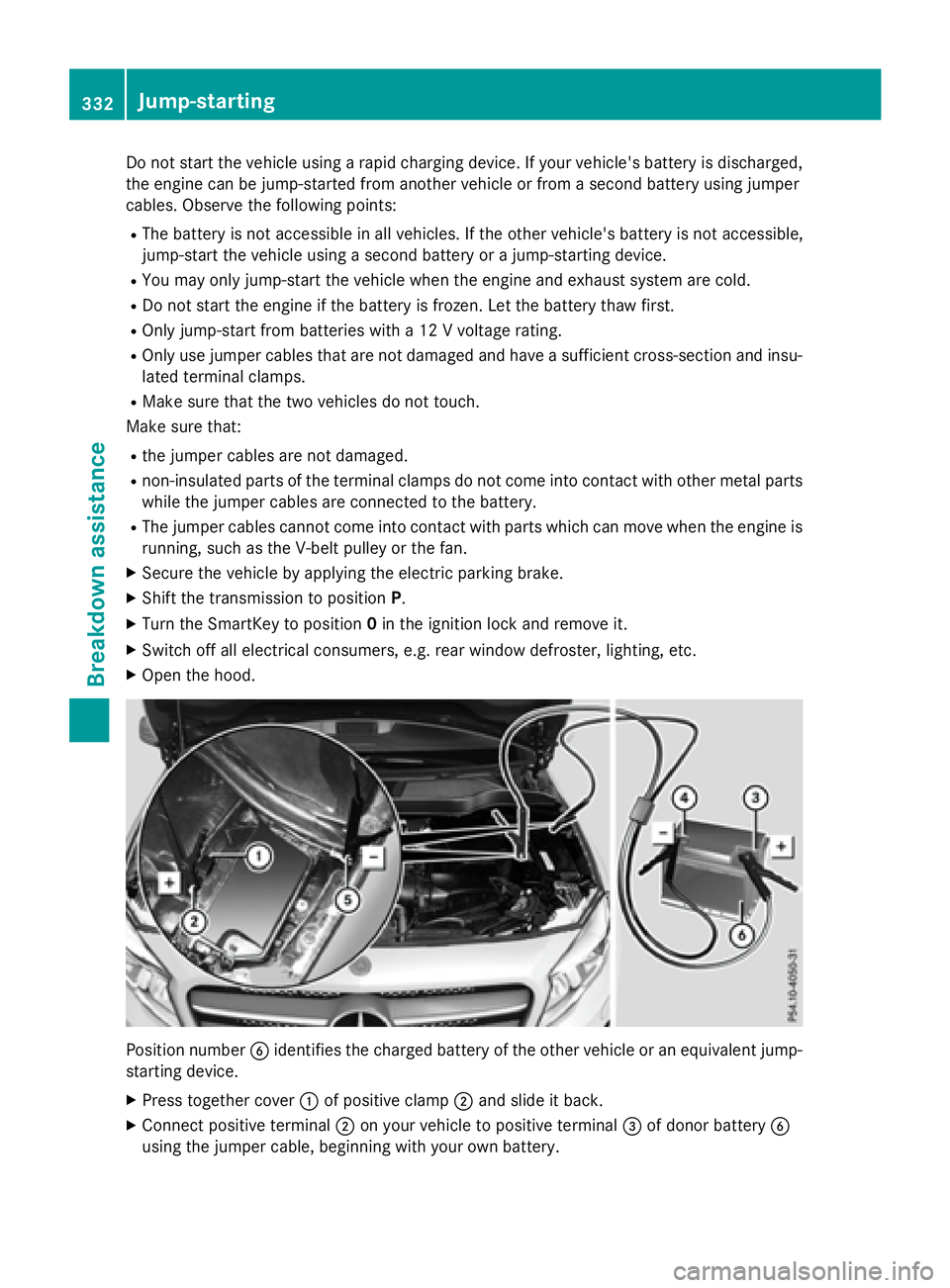
Do not start the vehicle using a rapid charging device. If your vehicle's battery is discharged,
the engine can be jump-started from another vehicle or from a second battery using jumper
cables. Observe the following points: R
The battery is not accessible in all vehicles. If the other vehicle's battery is not accessible,
jump-start the vehicle using a second battery or a jump-starting device. R
You may only jump-start the vehicle when the engine and exhaust system are cold. R
Do not start the engine if the battery is frozen. Let the battery thaw first. R
Only jump-start from batteries with a 12 V voltage rating. R
Only use jumper cables that are not damaged and have a sufficient cross-section and insu-
lated terminal clamps. R
Make sure that the two vehicles do not touch.
Make sure that: R
the jumper cables are not damaged. R
non-insulated parts of the terminal clamps do not come into contact with other metal parts
while the jumper cables are connected to the battery. R
The jumper cables cannot come into contact with parts which can move when the engine is
running, such as the V-belt pulley or the fan. X
Secure the vehicle by applying the electric parking brake. X
Shift the transmission to position P .X
Turn the SmartKey to position 0 in the ignition lock and remove it.X
Switch off all electrical consumers, e.g. rear window defroster, lighting, etc. X
Open the hood.
Position number �
Page 336 of 390
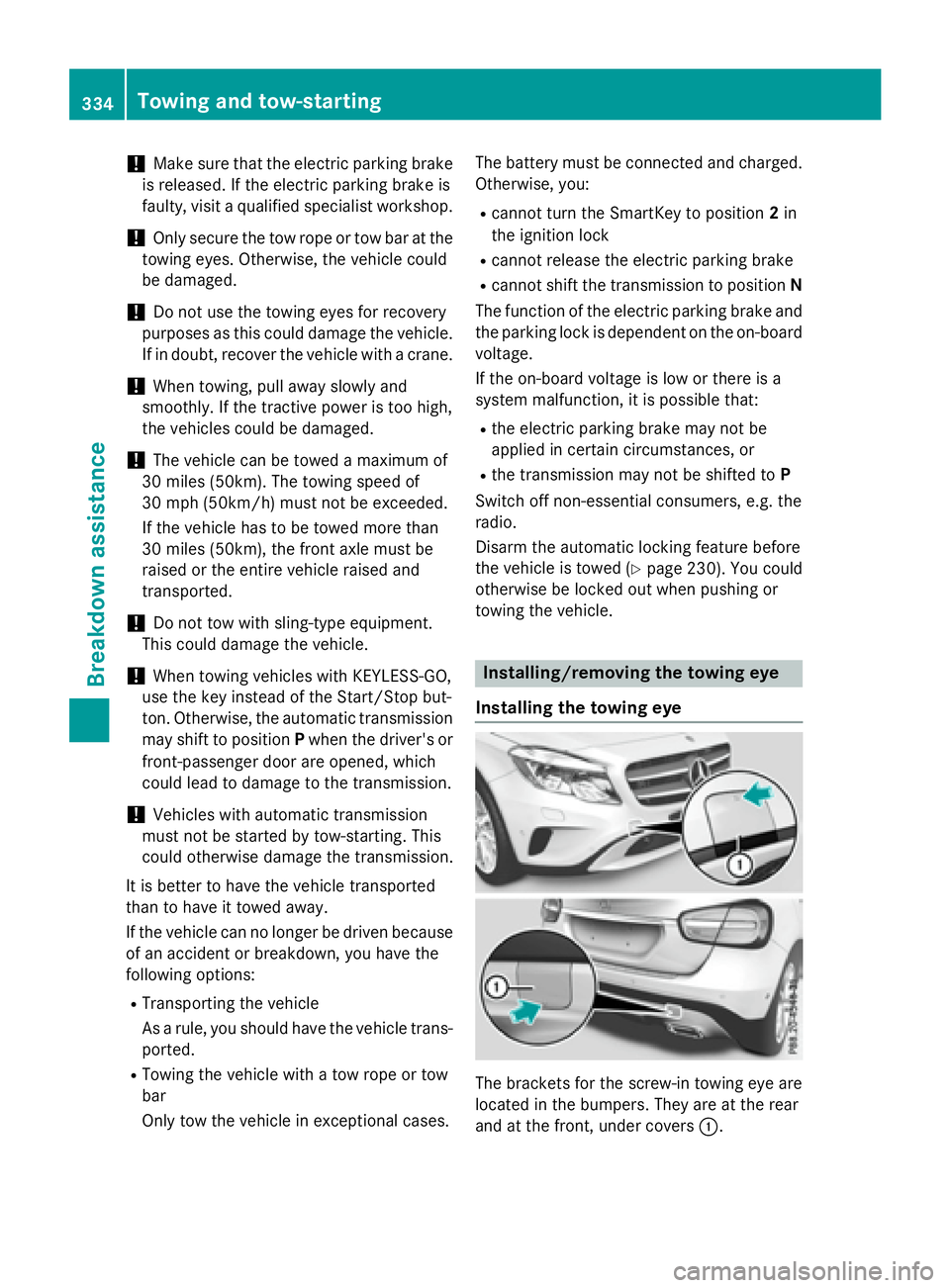
! Make sure that the electric parking brake
is released. If the electric parking brake is
faulty, visit a qualified specialist workshop.
! Only secure the tow rope or tow bar at the
towing eyes. Otherwise, the vehicle could
be damaged.
! Do not use the towing eyes for recovery
purposes as this could damage the vehicle.
If in doubt, recover the vehicle with a crane.
! When towing, pull away slowly and
smoothly. If the tractive power is too high,
the vehicles could be damaged.
! The vehicle can be towed a maximum of
30 miles (50km). The towing speed of
30 mph (50km/h) must not be exceeded.
If the vehicle has to be towed more than
30 miles (50km), the front axle must be
raised or the entire vehicle raised and
transported.
! Do not tow with sling-type equipment.
This could damage the vehicle.
! When towing vehicles with KEYLESS-GO,
use the key instead of the Start/Stop but-
ton. Otherwise, the automatic transmission
may shift to position P when the driver's or
front-passenger door are opened, which
could lead to damage to the transmission.
! Vehicles with automatic transmission
must not be started by tow-starting. This
could otherwise damage the transmission.
It is better to have the vehicle transported
than to have it towed away.
If the vehicle can no longer be driven because
of an accident or breakdown, you have the
following options: R
Transporting the vehicle
As a rule, you should have the vehicle trans-
ported. R
Towing the vehicle with a tow rope or tow
bar
Only tow the vehicle in exceptional cases. The battery must be connected and charged.
Otherwise, you: R
cannot turn the SmartKey to position 2 in
the ignition lock R
cannot release the electric parking brake R
cannot shift the transmission to position N
The function of the electric parking brake and
the parking lock is dependent on the on-board
voltage.
If the on-board voltage is low or there is a
system malfunction, it is possible that: R
the electric parking brake may not be
applied in certain circumstances, or R
the transmission may not be shifted to P
Switch off non-essential consumers, e.g. the
radio.
Disarm the automatic locking feature before
the vehicle is towed ( Y
page 230). You could
otherwise be locked out when pushing or
towing the vehicle.
Installing/removing the towing eye
Installing the towing eye
The brackets for the screw-in towing eye are
located in the bumpers. They are at the rear
and at the front, under covers �C .334
Towing and tow-starting
Breakdown assistance
Page 338 of 390
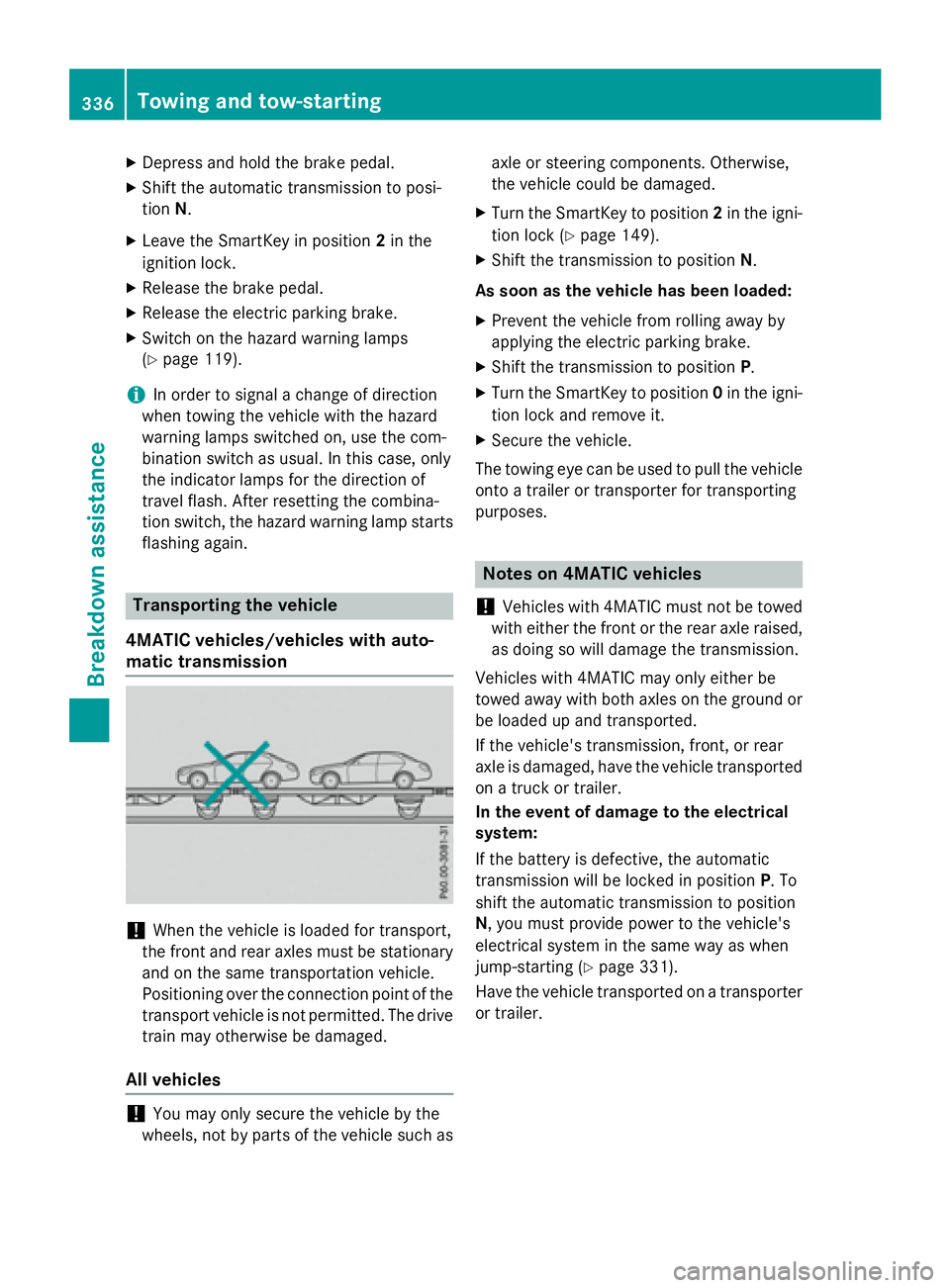
X
Depress and hold the brake pedal. X
Shift the automatic transmission to posi-
tion N .X
Leave the SmartKey in position 2 in the
ignition lock. X
Release the brake pedal. X
Release the electric parking brake. X
Switch on the hazard warning lamps
( Y
page 119).
i In order to signal a change of direction
when towing the vehicle with the hazard
warning lamps switched on, use the com-
bination switch as usual. In this case, only
the indicator lamps for the direction of
travel flash. After resetting the combina-
tion switch, the hazard warning lamp starts
flashing again.
Transporting the vehicle
4MATIC vehicles/vehicles with auto-
matic transmission
! When the vehicle is loaded for transport,
the front and rear axles must be stationary
and on the same transportation vehicle.
Positioning over the connection point of the
transport vehicle is not permitted. The drive
train may otherwise be damaged.
All vehicles
! You may only secure the vehicle by the
wheels, not by parts of the vehicle such as axle or steering components. Otherwise,
the vehicle could be damaged. X
Turn the SmartKey to position 2 in the igni-
tion lock ( Y
page 149). X
Shift the transmission to position N .
As soon as the vehicle has been loaded: X
Prevent the vehicle from rolling away by
applying the electric parking brake. X
Shift the transmission to position P .X
Turn the SmartKey to position 0 in the igni-
tion lock and remove it. X
Secure the vehicle.
The towing eye can be used to pull the vehicle
onto a trailer or transporter for transporting
purposes.
Notes on 4MATIC vehicles
! Vehicles with 4MATIC must not be towed
with either the front or the rear axle raised,
as doing so will damage the transmission.
Vehicles with 4MATIC may only either be
towed away with both axles on the ground or
be loaded up and transported.
If the vehicle's transmission, front, or rear
axle is damaged, have the vehicle transported
on a truck or trailer.
In the event of damage to the electrical
system:
If the battery is defective, the automatic
transmission will be locked in position P . To
shift the automatic transmission to position
N , you must provide power to the vehicle's
electrical system in the same way as when
jump-starting ( Y
page 331).
Have the vehicle transported on a transporter
or trailer.336
Towing and tow-starting
Breakdown assistance